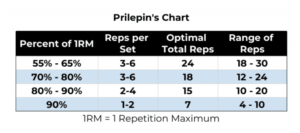Blog 33 – Furthering the SCIENCE!
So, remember last week when I said, “There’s also an intensity/intent component to the chart that is not included for the sake of simplicity here… Did someone just say foreshadowing?” Well here’s the follow through.
This statement was in reference to the very scientific Prilepin’s Chart – a simplified sets-and-reps framework that is backed by significant peer reviews, unbiased clinical trials, and factual accounts. *read: a bunch of bros, probably wearing spandex and racer back tanks* We’ll go a little deeper into the chart today and tie it back to one of the original blogs I wrote at the start of this whole thing (Can you believe we’re on Blog 33? I’m sure there’s a Lover of 3’s out there that will find significance in this…).
The extended version of Prilepin’s Chart looks like this (Yes, this is a different Prilepin’s Chart than shared last week. Yes, this has more categories. And yes, the numbers aren’t the same. But as I said before, this is highly specific and VERY scientific):

What’s significant here is the “Training Effect” column, which is separated into four main categories:
- Endurance (meaning muscular endurance not necessarily aerobic endurance)
- Explosive Power
- Hypertrophy (or Size)
- Strength
Other variations of the chart stick to 3 main categories, by lumping power and hypertrophy work together. Leaving us with basically a chart that classifies loading suggestions based on longer efforts, medium efforts, or shorter efforts OR something that pretty closely resembles what I so eloquently laid out some time ago in one of my first blogs (Yes, I could look it up. Yes, I could even link to it. No, I’m not going to.) – the three energy systems oxidative, glycolytic, and phosphagen. In this instance… Endurance = Oxidative. Hypertrophy/Power = Glycolytic. Strength = Phosphagen.
We could get really wild again, and layer in the energy system chart’s time component… which you could then, in turn, eliminate the reps prescription of Prilepin and replace it with a time component. (Did someone in the audience just say, Tabata? Or EMOM? Or AMRAP even? (Hopefully you’re having a moment where you’re recognizing that everything is everything… I’ll give you a minute… … Just breathe… … … …)
Applying this in our own training, the ideal workout or prescription is what gets you closest to your own goals. So we should think of what we really want out of our training sessions. Max strength? Then you’re shooting for a few reps with maximal loading. Want more explosive power or that first class ticket on board the GAINZ Train? Loading still needs to be heavy-ish but manageable and controllable. Looking for muscular endurance? … You get the picture. It should be noted here that YES you can get stronger without putting on much size because “size” or hypertrophy training is different than maximal strength training. At some point your strength will ultimately be limited by the size of your muscles, but to further debunk the I’m-going-to-get-too-muscular-if-I-lift-too-much-heavy-weight, maximal strength training is far more about neuromuscular coordination and efficiency than it is about size. Where hypertrophy training is about tearing down muscle fibers in order for them to regrow in a larger form. We simply don’t spend enough time under tension or do enough reps to create significant muscle damage and subsequent repair when we do something like a 1 Rep Max. (Liability note: This is not to say our risk for injury decreases because it doesn’t. It increases.) But all is to say; each type of training affects different part of the muscles in different ways – that is actually science.
Our programs at PDX Strength are about balance. We program, so that every one gets a little of every thing, but that is not to say you can’t create more of a training bias along the way. You want to feel more explosive? Take 2-3 months and change every strength session we do into a dynamic movement at about 70%. Want to get stronger? Same idea. Try to work in small and maximal sets above 90%. (Yes, I know you don’t like to not do the same thing everyone in class is doing. No, they won’t care.)
Hopefully this all seems relatively simple, but I understand that this blog still doesn’t necessarily give you the permission you need to feel empowered to change a workout, but is a step closer in your own strength education. Coaches are at your fingertips, ready to punch your one-way ticket to GAINZville.
D